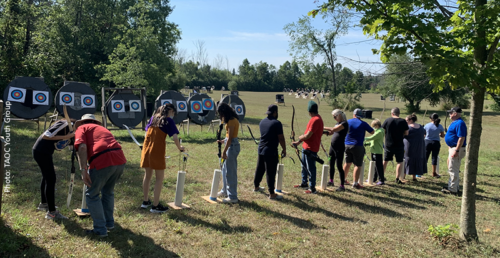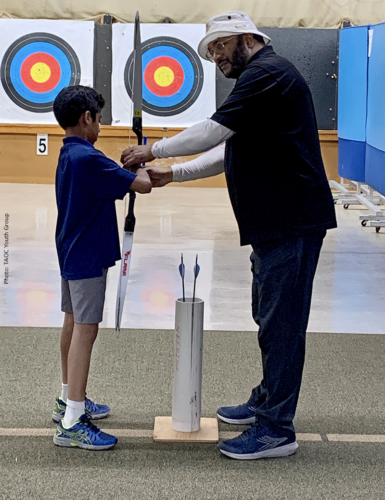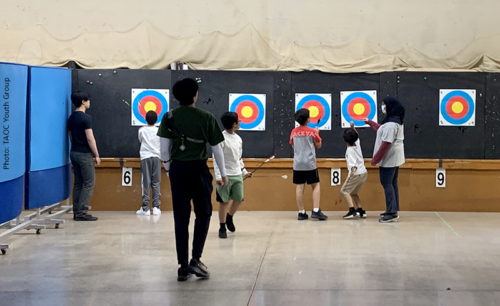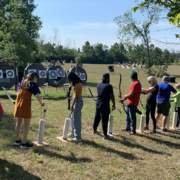On-target triumph: The Archers of Caledon’s COVID-19 micro grant-supported initiative inspires growth
 Established in the 1950s as the Humber Valley Archers and moving to Caledon in the 1960s, The Archers of Caledon (TAOC) has evolved into a full-service archery club in Ontario, catering to beginners, intermediate archers, and tournament enthusiasts. With about 200 members, the club offers group classes, private lessons, opportunities to play on tournament teams, and an archery school, providing opportunities for community members to engage with the club from various angles.
Established in the 1950s as the Humber Valley Archers and moving to Caledon in the 1960s, The Archers of Caledon (TAOC) has evolved into a full-service archery club in Ontario, catering to beginners, intermediate archers, and tournament enthusiasts. With about 200 members, the club offers group classes, private lessons, opportunities to play on tournament teams, and an archery school, providing opportunities for community members to engage with the club from various angles.
As pandemic restrictions eased, interest in archery locally was rising given the opportunities to be outdoors and as a minimal contact sport—it was seen as a safer sport option. One of the program’s coaches received information about Sport for Life’s COVID-18 micro-grants and forwarded the information to lead coach Mark D’Cunha with that growing interest in mind.
“One of the other senior coaches and I had been talking for probably two to three years about a youth program, and because we’d never had one before, we’d been getting a lot of requests for it. So, I decided to buckle down and write a proposal,” D’Cunha explained.
Positive impacts of Sport for Life’s COVID-19 micro-grant
The micro-grant that TAOC secured played a pivotal role in initiating that youth program. Initially, TAOC offered Try-It programs for youth aged six and up, eventually creating a separate youth program for ages eight and up.
 Responding to increased demand from parents of younger children, the club aimed to make archery accessible to kids as young as six. The grant enabled them to purchase specialized bows suitable for younger participants, including compound and recurve bows of varying weights. The club also invested in coach training, bolstering its coaching roster from eight to about 30 coaches today, with 15 to 20 active at any given time.
Responding to increased demand from parents of younger children, the club aimed to make archery accessible to kids as young as six. The grant enabled them to purchase specialized bows suitable for younger participants, including compound and recurve bows of varying weights. The club also invested in coach training, bolstering its coaching roster from eight to about 30 coaches today, with 15 to 20 active at any given time.
The youth program exceeded expectations, with eight weeks of classes selling out within three days of launch. Today, over six months since those initial programs, TAOC offers a consistent weekly youth program. It has not only attracted beginners but also fostered the development of competitive youth archers. Three participants, aged 10 to 13, were accepted into the Archery Canada youth enhancement program. There were also some unexpected benefits, such as providing programming for children on the ADHD spectrum and facilitating the inclusion of visually impaired archers.
“I’ve been very happy with the microgrant’s role and what it did for us because it created this new program that we didn’t have and was in demand by the community,” D’Cunha said.
The success prompted the club to apply for a further grant to establish an advanced youth program starting in early 2024 to fast-track young archers and provide tournament-level bows to ensure everyone can participate at a more affordable cost.
Challenges to consider
Challenges surfaced in meeting the growing demand, particularly in securing enough coaches and developing a strategy for competitive youth archers. The club leader emphasized the need for more competitive development coaches and judges at the club level. Looking ahead, the club plans to leverage additional grants to expand and enhance its offerings. The focus is on growing everything from beginner to tournament-level competitors, addressing challenges in equipment, coaches, and judges.
 Tangible takeaways
Tangible takeaways
In conclusion, the micro-grant jumpstarted a youth program and paved the way for the club’s expansion and community impact. Clubs seeking to navigate the post-pandemic landscape and engage their communities in quality sport initiatives can learn valuable lessons from TAOC. Key takeaways include starting small, adapting to the community’s needs, and leveraging grants for targeted initiatives. Additionally, focusing on smaller group engagements, involving parents in youth programs, and considering therapeutic aspects can contribute to sustained success in community sports programs.

